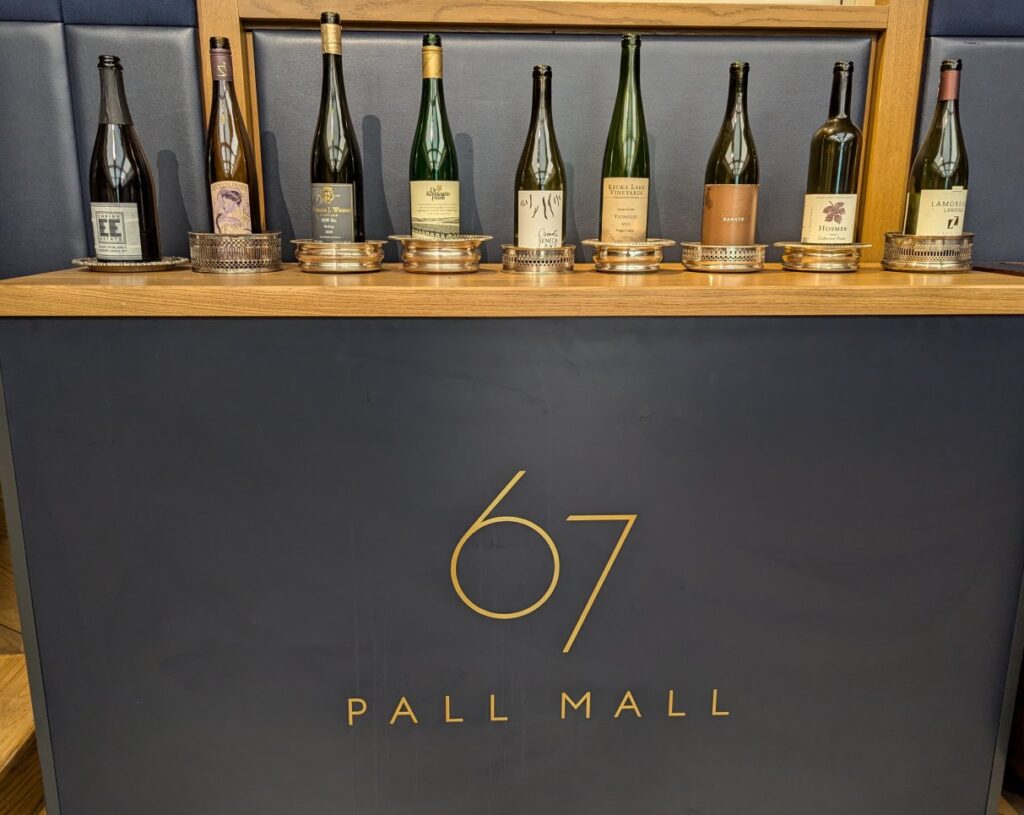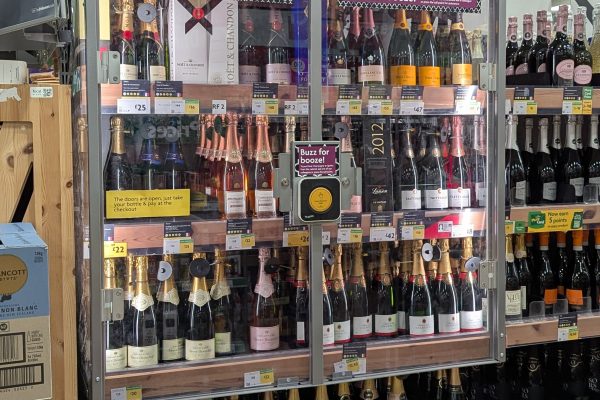In late November 2024, I attended a wine tasting event focused on the wines of New York State, presented by Jamie Goode. Jamie Goode, renowned for his book Wine Science, brought his expertise and insight to an intriguing exploration of a region not typically associated with wine production.
While New York State might not be a household name in the world of wine, it is, surprisingly, the third-largest producer in the United States. The wines featured in the tasting were predominantly from the Finger Lakes region, with one notable inclusion from Long Island. Over the course of the evening, we sampled nine wines, offering a diverse selection that included sparkling, white, orange and red.



Jamie Goode explained that there has been growing interest in New York State wines in recent years, driven by improving quality and an increasing focus on exporting to international markets.
New York State’s vineyards are characterised by a cool climate, which is influenced by a brief, warm season. The nearby lakes play a crucial role as thermal buffers, preventing temperatures from becoming excessively high or low. The region cultivates over 40 grape varieties, but the most prominent include Riesling, Chardonnay, Cabernet Franc and Merlot. Of these, Riesling and Cabernet Franc are particularly significant, not only for their quality but also for their resistance to the cold, making them well-suited to the challenging climate.
The wines we tried were:

Empire Estate Blanc de Blancs NV, from the Finger Lakes, was served during the welcome reception. With an ABV of 12%, it is made entirely from Riesling, though this isn’t immediately apparent and could have been mistaken for Chardonnay. Crafted using the traditional method, its base wines are drawn from a perpetual reserve, preserving consistency while adding complexity and depth. I thought this wine proved much more enjoyable when slightly warmed from chilled, revealing aromas of green apple, lemon and a subtle hint of toasted brioche. On the palate, it offered vibrant notes of citrus and stone fruits, supported by a well-rounded body. This sparkling wine stood out as one of the more affordable options in the tasting, representing excellent value for a traditional-method sparkling wine. It is priced at £28.50 from Good Wine Good People.
The Knoll Riesling, Apollo’s Praise, 2023, from the Finger Lakes is named after a small sandstone hill, or ‘knoll’, that rises prominently within the Lahoma vineyard, one of four hills that define the site. This wine, made entirely from Riesling and with an ABV of 13%, is dry yet delivers a rich, full-fruit profile. Its aroma is marked by apricot, which transitions into a palate dominated by apricot marmalade and lemon. Despite its light colour, the wine is surprisingly full-bodied, with a rounded texture that coats the tongue, offering a satisfying and lingering experience. It was unanimously the favourite among those at the tasting. However, many noted that its £50 price tag, available from Handford Wines and Divine Cellars, felt a bit steep, despite the wine’s undeniable quality.
HJW Bio Riesling 2020, from Hermann J. Wiemer in the Finger Lakes, is an organic and biodynamic wine, made entirely from Riesling with an ABV of 12.5%. On the nose, it offers inviting aromas of honey, lime, and stone fruits. The palate reveals flavours of pear and apple, complemented by a touch of lemon and a hint of sweetness. Compared to The Knoll Riesling, this wine has a more pronounced acidity, giving it a fresher, more vibrant profile. Its character is more reminiscent of a classic German Riesling. Priced at £37.50 from Wanderlust Wine.
Dry Riesling 2023, from Dr. Konstantin Frank Winery in the Finger Lakes, is a standout example of the region’s potential. Made entirely from Riesling and with an ABV of 12%, this wine is highly aromatic, offering enticing floral notes alongside sweet mandarin on the nose. These citrus tones carry through to the palate, where mandarin and grapefruit dominate, complemented by a remarkable freshness. While its unique character is atypical of Riesling, this distinctiveness, the aromatics and flavour made it one of my personal favourites of the evening. At £19 from Wine Hub Devon, it represents good value.
The 2023 Chardonnay from Osmote, sourced from Seneca Lake in the Finger Lakes, is a a more elegant expression of this variety. With an ABV of 12%, it was spontaneously barrel-fermented, giving it a nuanced character that deviates from the bold, full-on Chardonnays one might expect. This wine offers a lighter mouthfeel with a refreshing acidity and a subtle touch of oak. On the nose and palate, it has notes of lemon, apple and a distinctive saline quality. While delicate, it retains plenty of flavour. Priced at £30 from Woodwinters, perfect for those seeking a lighter, fresher take on the grape.
The 2022 Vignoles from Keuka Lake Vineyards in the Finger Lakes is an intriguing wine made entirely from the Vignoles grape, a hybrid variety developed to resist powdery mildew. With an ABV of 12.1%, it offers a fascinating departure from the other wines in the tasting. Jamie provided context on hybrid grapes, explaining how they were historically created to combat threats like phylloxera. This wine has a deeper golden hue compared to the previous, hinting at its unique character. On the palate and nose, it reveals an unusual yet enticing curious mix of apple, citrus and orange notes. Its distinct profile made it a memorable addition to the tasting. £18 from Ally Wines.
Ramato from Channing Daughters, 2022, on Long Island is a striking example of an ‘orange’ wine, made from 98% Pinot Grigio and 2% Muscat with an ABV of 12%. Its light copper colour, reminiscent of a rosé, is a visual clue to its name, Ramat, an Italian word that refers to the copper hue achieved through skin fermentation. Crafted in the old Friulian style, the Pinot Grigio grapes are fermented on their skins, resulting in a wine that is nothing like the typical expression of this variety. On the palate, it offers bold notes of grapefruit, citrus, and spice, complemented by a dry finish and medium tannins. This unique wine is a far cry from the Pinot Grigios most are familiar with, offering a truly distinctive and different experience. Priced at £25 from Wanderlust Wine, it is an intriguing choice for anyone looking to explore the fascinating world of skin-fermented orange wines.
This 2022 Cabernet Franc from Hosmer Winery in the Finger Lakes is a lighter expression of this varietal, made entirely from Cabernet Franc with an ABV of 12.4%. On the nose, it offers bright aromas of raspberry and cherry, which transition seamlessly into flavours of strawberry with a subtle hint of fennel on the palate. This is a more delicate red, with low to medium tannins that enhance its approachable and refined character. Priced at £37 from Vineyard Cellars, it is an elegant choice for those who appreciate a softer, lighter style of red wine.
T23 Cabernet Franc 2022 from Lamoreaux Landing Wine Cellars in the Finger Lakes is an example of an unoaked Cabernet Franc, offering a pure and expressive take on the variety. With an ABV of 12%, it is made entirely from Cabernet Franc, showcasing the grape’s natural character. The starts with aromas of black cherries, complemented by subtle herbal notes. On the palate, it displays a fascinating blend of herbal undertones and low tannins. Medium-bodied yet light and powerful, it strikes a unique balance that keeps you intrigued. Its savoury and spicy profile, reminiscent of a great New Zealand Pinot Noir, adds to its complexity. Priced at £20, this wine is good value and available from Good Wine Good People, Cheers Wine Merchants, Shaftesbury Wines, Barrique Fine Wines and other independent retailers. For me, it stood out as one of the most intriguing wines of the tasting.
Overall, the wines from New York State proved to be full of surprises, often defying the expectations typically associated with the varietals on their labels. There is little in the way of typicity for this region or grapes. Conversely, this lack of uniformity makes the wines intriguing, as they are best approached individually for their unique nuances and characteristics.
Rather than the region gaining a reputation for a specific type of wine, the focus is on the distinctiveness of each bottle. Price wise, while one or two of the prices felt on the higher side, this is consistent with the cost of most U.S. wines in the UK. It’s also important to remember that these are low-production, artisan wines, crafted with care and offering something genuinely different to explore.














